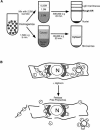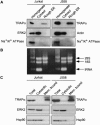Partitioning and translation of mRNAs encoding soluble proteins on membrane-bound ribosomes
- PMID: 12923260
- PMCID: PMC1370476
- DOI: 10.1261/rna.5610403
Partitioning and translation of mRNAs encoding soluble proteins on membrane-bound ribosomes
Abstract
In eukaryotic cells, it is generally accepted that protein synthesis is compartmentalized; soluble proteins are synthesized on free ribosomes, whereas secretory and membrane proteins are synthesized on endoplasmic reticulum (ER)-bound ribosomes. The partitioning of mRNAs that accompanies such compartmentalization arises early in protein synthesis, when ribosomes engaged in the translation of mRNAs encoding signal-sequence-bearing proteins are targeted to the ER. In this report, we use multiple cell fractionation protocols, in combination with cDNA microarray, nuclease protection, and Northern blot analyses, to assess the distribution of mRNAs between free and ER-bound ribosomes. We find a broad representation of mRNAs encoding soluble proteins in the ER fraction, with a subset of such mRNAs displaying substantial ER partitioning. In addition, we present evidence that membrane-bound ribosomes engage in the translation of mRNAs encoding soluble proteins. Single-cell in situ hybridization analysis of the subcellular distribution of mRNAs encoding ER-localized and soluble proteins identify two overall patterns of mRNA distribution in the cell-endoplasmic reticular and cytosolic. However, both partitioning patterns include a distinct perinuclear component. These results identify previously unappreciated roles for membrane-bound ribosomes in the subcellular compartmentalization of protein synthesis and indicate possible functions for the perinuclear membrane domain in mRNA sorting in the cell.
Figures








References
-
- Bassell, G.J., Oleynikov, Y., and Singer, R.H. 1999. The travels of mRNAs through all cells large and small. FASEB J. 13: 447–454. - PubMed
-
- Brooks, J.C. and Treml, S. 1984. Effect of trifluoperazine and calmodulin on catecholamine secretion by saponin-skinned cultured chromaffin cells. Life Sci. 34: 669–674. - PubMed
Publication types
MeSH terms
Substances
Grants and funding
LinkOut - more resources
Full Text Sources
Other Literature Sources
